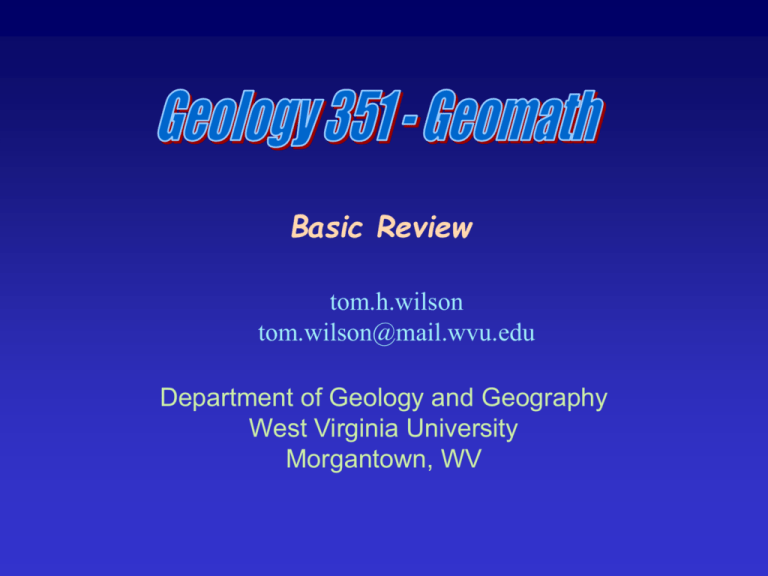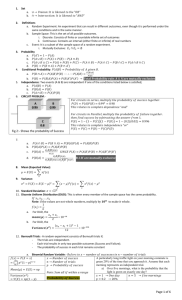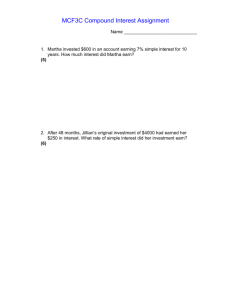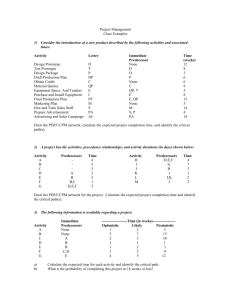What are the intercepts? - West Virginia University
advertisement

Basic Review tom.h.wilson tom.wilson@mail.wvu.edu Department of Geology and Geography West Virginia University Morgantown, WV Let’s take a short tour of the Excel files provided by Waltham that are coordinated with text exercises and discussions Click on this link Take a look at the following: Intro.xls Exp.xls Integ.xls 1. 2 2. 0 3. 5 4. 1 5. 5 6. 6 7. 2 8. 11 9. 3 10. 2 11. 2 8’ 6’ Subscripts and superscripts provide information about specific variables and define mathematical operations. k1 and k2 for example could be used to denote sedimentation constants for different areas or permeabilities of different rock specimens. See Waltham for additional examples of subscript notation. The geologist’s use of math often turns out to be a periodic and necessary endeavor. As time goes by you may find yourself scratching your head pondering oncemastered concepts that you suddenly find a need for. This is often the fate of basic power rules. Evaluate the following xaxb = xa+b xa / xb = xa-b (xa)b = xab a 5 5a 5 log a a log 5 | none of these a b c a b a c | a b a c | ca b | (b c ) log a f f g g a ( f g ) log a | a | a | none of these a g a 0 0 |1| a | none of these f ( a b ) c a b a c | a b c | a bc | none of these Question 1.2a Simplify and where possible evaluate the following expressions - i) 32 x 34 ii) (42)2+2 iii) gi . gk iv) D1.5. D2 Exponential notation is a useful way to represent really big numbers in a small space and also for making rapid computations involving large numbers - for example, the mass of the earth is 5970000000000000000000000 kg the mass of the moon is 73500000000000000000000 kg Express the mass of the earth in terms of the lunar mass. While you’re working through that with pencil and paper let me write down these two masses in exponential notation. ME = 597 x 1022kg MM = 7.35 x 1022kg The mass of the moon (MM) can also be written as 0.0735 x 1024kg Hence, the mass of the earth expressed as an equivalent number of lunar masses is M E(M ) ME 597 x1022 597 MM 7.35 x1022 7.35 =81.2 lunar masses Write the following numbers in exponential notation (powers of 10)? The mass of the earth’s crust is 28000000000000000000000kg The volume of the earth’s crust is 10000000000000000000 m3 The mass of the earth’s crust is 2.8 x 1022 kg The volume of the earth’s crust is 1 x 10 19 m3 =mass/volume = 2.8 x 103 kg/m3 Differences in the acceleration of gravity on the earth’s surface (and elsewhere) are often reported in milligals. 1 milligal =10-5 meters/second2. This is basically a unit conversion problem - you are given a value in one system of units, and the relation of requested units (in this case milligals) to the given units (in this case meters/s2) 1 milligal = 10-5 m/s2 hence 1 m/s2 in terms of milligals is found by multiplying both sides of the above equation by 105 to yield 105 milligals= 1m/s2 - thus g=(9.8m/s2) x 105 milligals/(m/s2) =9.8 x 105 milligals The earth gains mass every day due to collision with (mostly very small) meteoroids. Estimate the increase in the earth’s mass since its formation assuming that the rate of collision has been constant and that M 6 x105 kg day t Ae 4.5 x109 years M/ t is the rate of mass gain Ae is the age of the earth (our t) AE 365 days year But, what is the age of the earth in days? 1.6425x10 12 days x 4.5 x 109 years 1) What is the total mass gained? 2) Express the mass-gain as a fraction of the earth’s present day mass i.e. AE (M / t ) M E 5.95 x10 24 kg 9.855 x1017 7 M 1 . 66 x 10 ME E 24 5.95 x10 The North Atlantic Ocean is getting wider at the average rate vs of 4 x 10-2 m/y and has width w of approximately 5 x 106 meters. 1. Write an expression giving the age, A, of the North Atlantic in terms of vs and w. 2. Evaluate your expression to answer the question - When did the North Atlantic begin to form? How thick was it originally? Over what length of time was it deposited? 510,000 years 0.5 to 2.1 million years ago 2.1 to 2.7 million years ago http://www.nasa.gov/mission_pages/MRO/multimedia/phillips-20080515.html http://www.sciencedaily.com/releases/2008/04/080420114718.htm The example presented on page 3 illustrates a simple age-depth relationship for unlithified sediments Age k x depth This equation is a quantitative statement of what we all have an intuitive understanding of - increased depth of burial translates into increased age of sediments. But as Waltham suggests - this is an approximation of reality. What does this equation assume about the burial process? Is it a good assumption? symbolic notation a kz where a=age, z=depth Example - if k = 1500 years/m calculate sediment age at depths of 1m, 2m and 5.3m. Repeat for k =3000 years/m 1m Age = 1500 years 2m Age = 3000 years 5.3m Age = 7950 years For k = 3000years/m Age = 3000 years Age = 6000 years Age = 15900 years You probably recognized that the equation we started with Age k x Depth is the equation of a straight line. The general equation of a straight line is y mx b In this equation - y mx b which term is the slope and which is the intercept? In this equation Age k x Depth - which term is the slope and which is the intercept? k is the slope of the line the intercept must be zero A more generalized representation of the age/depth relationship should include an intercept term A kD A 0 The slope of the line is, in this case, an inverse rate. Our dependant variable is depth, which would have units of meters or feet, for example. The equation defines depth of burial in terms of age. K, the slope transforms a depth into a number of years and k must have units of years/depth. The geologic significance of A0 - the intercept - could be associated with the age of the upper surface after a period of erosion. Hence the exposed surface of the sediment deposit would not be the result of recent sedimentation but instead would be the remains of sediments deposited at an earlier time A0. 50000 AGE (years) 40000 A kD A 0 30000 20000 10000 0 0 20 40 60 Depth (meters) 80 100 A kD A 0 AGE (years) 150000 100000 The slope of this line is t/x =1500years/meter, what is the intercept? t 50000 x 0 -50000 -20 0 20 40 60 depth (meters) 80 100 The intercept is the line’s point of intersection along the y (or Age) axis at depth =0. If only the relative ages of the sediments are known, then for a given value of k (inverse deposition rate) we would have a family of possible lines defining age versus depth. 70000 AGE (years) 60000 50000 40000 30000 20000 What are the intercepts? 10000 0 -10000 0 20 40 60 80 Depth (meters) Are all these curves realistic? 100 Consider the case for sediments actively deposited in a lake. A kD A 0 Consider the significance of A0 in the following context If k is 1000 years/meter, what is the velocity that the lake bed moves up toward the surface? If the lake is currently 15 meters deep, how long will it take to fill up? A kD A 0 The slope (k) does not change. We still assume that the thickness of the sediments continues to increase at the rate of 1 meter in 1000 years. What is the intercept? Hint: A must be zero when D is 15 meters You should be able to show that A0 is 15,000 years. That means it will take 15,000 years for the lake to fill up. 1x10 Age (years) 5x10 5 present day depth at age = 0. 4 0 Age =? -5x10 -1x10 -15,000 4 5 -50 0 50 Depth (meters) 100 Our new equation looks like this - A 1000 D - 15,000 1x10 Age (years) 5x10 -5x10 -1x10 5 4 0 4 5 -50 0 50 Depth (meters) 100 A kD A 0 Is this a good model? … we would guess that the increased weight of the overburden would squeeze water from the formation and actually cause grains to be packed together more closely. Thus meter thick intervals would not correspond to the same interval of time. Meter-thick intervals at greater depths would correspond to greater intervals of time. We might also guess that at greater and greater depths the grains themselves would deform in response to the large weight of the overburden pushing down on each grain. These compaction effects make the age-depth relationship non-linear. The same interval of depth D at large depths will include sediments deposited over a much longer period of time than will a shallower interval of the same thickness. The relationship becomes non-linear. The line y=mx+b really isn’t a very good approximation of this age depth relationship. To characterize it more accurately we have to introduce non-linearity into the formulation. So let’s start looking at some non-linear functions. Quadratic vs. Linear Behavior Compare the functions 150000 A 1000 D - 15,000 100000 and (in red) Age 50000 A 3D2 1000 D - 15,000 0 What kind of equation is this? -50000 -100000 -50 0 50 Depth (meters) 100 This is a quadratic equation. The general form of a quadratic equation is y ax 2 bx c Quadratics 125 y 2 x 2 10 x 20 75 y 2x 2 Y 25 y 3x 2 60 -25 -75 -6 -4 -2 0 X 2 4 6 One equation differs form that used in the text The increase of temperature with depth beneath the earth’s surface is a non-linear process. Waltham presents the following table Depth (km) 0 100 400 700 2800 5100 6360 5000 4000 o Temperature ( C) 10 1150 1500 1900 3700 4300 4300 3000 T 2000 1000 0 0 1000 2000 3000 4000 Depth (km) 5000 6000 7000 We see that the variations of T with Depth are nearly linear in certain regions of the subsurface. In the upper 100 km the relationship T 20 x 10 provides a good approximation. 5000 From 100-700km the relationship T 1.25 x 1017 works well. 4000 3000 T 2000 Can we come up with an equation that will fit the variations of temperature with depth - for all depths? Let’s try a quadratic. 1000 0 0 1000 2000 3000 4000 Depth (km) 5000 6000 7000 The quadratic relationship plotted below is just one possible relationship that could be derived to explain the temperature depth variations. T (1.537 x10 4 ) x 2 1.528 x 679 .77 5000 4000 3000 T 2000 1000 0 0 1000 2000 3000 4000 Depth (km) 5000 6000 7000 The formula - below right - is presented by Waltham. In his estimate, he has not tried to replicate the variations of temperature in the upper 100km of the earth. T (1.537 x10 4 ) x 2 1.53 x 680 T (8.255 x10 5 ) x 2 1.05 x 1110 5000 5000 4000 4000 3000 3000 T T 2000 2000 1000 1000 0 0 0 1000 2000 3000 4000 Depth (km) 5000 6000 7000 0 1000 2000 3000 4000 Depth (km) 5000 6000 7000 5000 5000 4000 4000 3000 3000 O T( C) Either way, the quadratic approximations do a much better job than the linear ones, but, there is still significant error in the estimate of T for a given depth. T 2000 2000 1000 1000 0 0 1000 2000 3000 4000 5000 6000 7000 0 0 1000 2000 3000 4000 Depth (km) Depth (km) Can we do better? 5000 6000 7000 To do so, we explore the general class of functions referred to as polynomials. A polynomial is an equation that includes x to the power 0, 1, 2, 3, etc. The straight line y mx b is referred to as a first order polynomial. The order corresponds to the highest power of x present in the equation - in the above case the highest power is 1. The quadratic y ax 2 bx c is a second order Polynomial, and the equation y ax n bx n 1 cx n 2 ... a0 is an nth order polynomial. y ax n bx n 1 cx n 2 ... a0 In general the order of the polynomial tells you that there are n-1 bends in the data or n1 bends along the curve. The quadratic, for example is a second order polynomial and it has only one bend. But the number of bends in the data is not necessarily a good criteria for determining what order polynomial should be used to represent the data. The temperature variations rise non-linearly toward a maximum value (there is one bend in the curve), however, the quadratic equation (second order polynomial) does not do an adequate job of defining these variations with depth. 5000 Noting the number of bends in the curve might provide you with a good starting point. You could then increase the order to obtain further improvements. 4000 3000 T 2000 1000 0 0 1000 2000 3000 4000 Depth (km) 5000 6000 7000 Waltham offers the following 4th order polynomial as a better estimate of temperature variations with depth. T 1.12 x10 12 d 4 2.85 x10 8 x3 0.00031 x 2 1.64 x 930 5000 4000 3000 T 2000 1000 0 0 1000 2000 3000 4000 Depth (km) 5000 6000 7000 Here is another 4th order polynomial which in this case attempts to fit the near-surface 100km. Notice that this 4th order equation (redline plotted in graph) has three bends or turns. T 1.289 x10 11 d 4 1.99 x10 7 x3 0.00113 x 2 3.054 x 394 .41 th 4 Polynomial 5000 4000 T 3000 2000 1000 0 0 1000 2000 3000 4000 Depth (km) 5000 6000 7000 In sections 2.5 and 2.6 Waltham reviews negative and fractional powers. The graph below illustrates the set of curves that result as the exponent p in y ax p a0 Power Laws is varied from 2 to -2 in 0.25 steps, and a0 equals 0. Note that the negative powers rise quickly up along the y axis for values of x less than 1 and that y rises quickly with increasing x for p greater than 1. 2 2 4 2 What is 0.01 X -2 1000 800 Y 600 X -1.75 400 X 200 0 1 2 3 x ? 2 X 0 What is 0.01 ? 2 1200 4 5 1.75 Power Laws - A power law relationship relevant to geology describes the variations of ocean floor depth as a function of distance from a spreading ridge (x). d ax1 / 2 d 0 Ocean Floor Depth 0 1 Spreading Ridge 2 D (km) 3 4 5 0 200 400 600 800 1000 X (km) What physical process do you think might be responsible for this pattern of seafloor subsidence away from the spreading ridges? Section 2.7 Allometric Growth and Exponential Functions Allometric - differential rates of growth of two measurable quantities or attributes, such as Y and X, related through the equation Y=abX - This topic brings us back to the age/thickness relationship. Earlier we assumed that the length of time represented by a certain thickness of a rock unit, say 1 meter, was a constant for all depths. However, intuitively we argued that as a layer of sediment is buried it will be compacted - water will be squeezed out and the grains themselves may be deformed. The open space or porosity will decrease. Waltham presents us with the following data table Depth (km) 0 1 2 3 4 Porosity () 0.6 0.3 0.15 0.075 0.0375 Over the range of depth 0-4 km, the porosity decreases from 60% to 3.75%! 0.6 Porosity 0.5 0.4 0.3 0.2 0.1 0.0 0.00 0.50 1.00 1.50 2.00 Depth 2.50 3.00 3.50 4.00 This relationship is not linear. A straight line does a poor job of passing through the data points. The slope (gradient or rate of change) decreases with increased depth. 0.6 Porosity 0.5 0.4 0.3 0.2 0.1 0.0 -0.1 0 1 2 3 4 5 Depth Waltham generates this data using the following relationship. 0.6 x 2 z 0.6 x 2 z This equation assumes that the initial porosity (0.6) decreases by 1/2 from one kilometer of depth to the next. Thus the porosity () at 1 kilometer is 2-1 or 1/2 that at the surface (i.e. 0.3), (2)=1/2 of (1)=0.15 (i.e. =0.6 x 2-2 or 1/4th of the initial porosity of 0.6. Equations of the type y ab cx are referred to as allometric growth laws or exponential functions. z (0.6)2 In the equation y ab cx a=? a=0.6 b=? b=2 c=? c= -1 The constant b is referred to as the base. Recall that in relationships like y=10a, a is the power to which the base 10 is raised in order to get y. The porosity-depth relationship is often stated using a base different than 2. The base which is most often used is the natural base e and e equals 2.71828 .. In the geologic literature you will often see the porosity depth relationship written as 0 e-cz 0 is the initial porosity, c is a compaction factor and z - the depth. Sometimes you will see such exponential functions written as -cz 0 exp In both cases, e=exp=2.71828 Waltham writes the porosity-depth z relationship as - 0 e Note that since z has units of kilometers (km) that c must have units of km-1 and must have units of km. Note that in the above form 0 e 0 e - - z when z=, 0 e-1 0.3680 represents the depth at which the porosity drops to 1/e or 0.368 of its initial value. In the form 0 e-cz c is the reciprocal of that depth. Logarithms Above, when we talked about functions like y ab cx and y a10 cx b and 10 are what we refer to as bases. These are constants and we can define any other number in terms of these constants raised to a certain power. Given any number y, we can express y as 10 raised to some power x Thus, given y =100, we know that x must be equal to 2. i.e. y 10 x y 10 x By definition, we also say that x is the log of y, and can write log y log 10 x x So the powers of the base are logs. “log” can be thought of as an operator like x and which yields a certain result. Unless otherwise noted, the operator “log” is assumed to represent log base 10. So when asked what is log y, where y 45 We assume that we are asking for x such that 10 x 45 Sometimes you will see specific reference to the base and the question is written as log 10 y, where y 45 log 10 y leaves no room for doubt that we are specifically interested in the log for a base of 10. One of the confusing things about logarithms is the word itself. What does it mean? You might read log10 y to say ”What is the power that 10 must be raised to to get y?” How about this operator? - pow10 y The power of base 10 that yields () y log 10 y 1.653 What do you think? Are small earthquakes much more common than large ones? Fortunately, the answer to this question is yes, but is there a relationship between the size of an earthquake and the number of such earthquakes? N/year 537.03 389.04 218.77 134.89 91.20 46.77 25.70 16.21 8.12 4.67 2.63 0.81 0.66 2.08 1.65 1.09 0.39 0.23 0.15 0.12 0.08 0.04 0.03 Observational data for earthquake magnitude (m) and frequency (N, number of earthquakes per year with magnitude greater than m) 600 Number of earthquakes per year m 5.25 5.46 5.7 5.91 6.1 6.39 6.6 6.79 7.07 7.26 7.47 7.7 7.92 7.25 7.48 7.7 8.11 8.38 8.59 8.79 9.07 9.27 9.47 500 400 300 200 100 0 5 6 7 8 9 10 Richter Magnitude What would this plot look like if we plotted the log of N versus m? Number of earthquakes per year 1000 100 10 1 0.1 0.01 5 6 7 8 9 10 Richter Magnitude This looks like a linear relationship. Recall the formula for a straight line? y mx b Number of earthquakes per year 1000 What would y be in this case? 100 y log N 10 1 What is b? 0.1 the intercept 0.01 5 6 7 8 Richter Magnitude 9 10 The Gutenberg-Richter Relation Number of earthquakes per year 1000 log N bm c 100 10 -b is the slope and c is the intercept. 1 0.1 0.01 5 6 7 8 Richter Magnitude 9 10 3 Log of the Number of Earthquakes per Year Log of the Number of Earthquakes per Year 3 2 1 0 -1 -2 2 1 0 -1 -2 0 50 100 150 200 250 300 350 400 Square Root of Fault Plane Area (kilometers) (Characteristic Linear Dimension) 1 10 100 1000 Square Root of Fault Plane Area (kilometers) (Characteristic Linear Dimension) In passing, also note that the magnitude axis can be replaced with the square root of fault plane area since earthquake magnitude is proportional to the square root of area of the fault plane along which rupture occurred. This relationship is linear in the log-log plot shown above right. Based on the preceding comment, it should be no surprise that we also find a similar relationship between the number of faults of length greater than or equal to a given size at a particular outcrop location 12000 10000 8000 N 6000 4000 2000 0 0 2 4 6 8 10 Fault Length (meters) Another nice attribute of logs is that when you plot the log of y (i.e. the power that 10 (or some other base) has to be raised to to yield y) rather than y itself, it is easier to see relative differences in the value y. For example, replotting the N vs L data on logN vs. log(L) scale we get a straight line and can easily see the relationship of differences in N relative to size L. 10000 1000 N 100 10 1 0.001 0.01 0.1 1 10 Fault Length (meters) In this case, we see that the log-log relationship is linear. Sometimes the labels on the axes will consist only of the exponent (log or power) itself. Thus, as shown below, the gridlines are labeled 100 or just 0, 101 or just 1, etc. 10000 1000 N 100 10 1 -3 exponent only 10 -3 10 -2 -2 10 -1 -1 10 0 Fault Length (meters) 0 10 1 1 The Gutenberg-Richter Relation log N bm c Number of earthquakes per year 1000 100 10 1 0.1 0.01 5 6 7 8 Richter Magnitude 9 10 is linear in a log-log format because m is earthquake magnitude and you have heard that an earthquake magnitude of 5, for example, represents ground motion whose amplitude is 10 times that associated with a magnitude 4 earthquake. One of the most commonly used “Richter magnitude” scales determines the magnitude of shallow earthquakes from surface waves according to the following equation m log10 A 1.66 log 3.3 T where T is the period in seconds, A the maximum amplitude of ground motion in m (10-6 meters) and is the epicentral distance in degrees between the earthquake and the observation point. We’ve already worked with three bases - 2, 10 and e. Whatever the base, the logging operation is the same. log 5 10 asks what is the power that 5 must be raised to to get 10. log 5 10 ? How do we find these powers? log 5 10 log10 10 log10 5 1 log 5 10 1.431 0.699 thus 51.431 10 In general, log base (some number) log10 (number) log10 base or log b a log10 (a) log10 b Try the following on your own log 3 7 log10 (7) ? log10 3 log 8 8 log 7 21 log 4 7 You will find that log 10 is often writ ten as log, with no subscript log10 is referred to as the common logarithm log e is often writ ten as ln. thus log e 8 ln8 2.079 loge or ln is referred to as the natural logarithm. All other bases are usually specified by a subscript on the log, e.g. log 5 or log 2 , etc. Finish reading Chapters 1 and 2 (pages 1 through 38) of Waltham After we finish our basic review, we will learn how to use Excel a scientific computing and graphing software package to solve some problems related to the material covered in Chapters 1 and 2.





